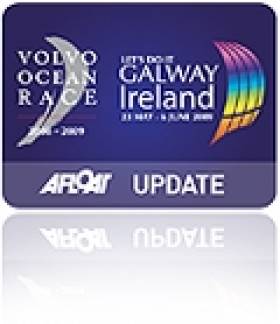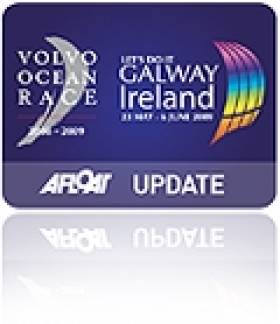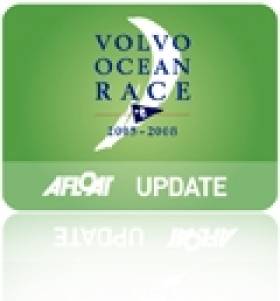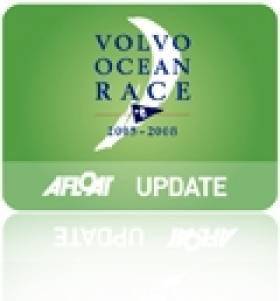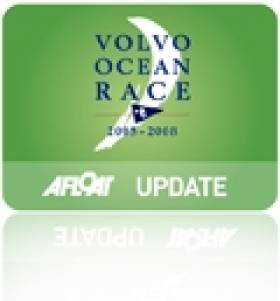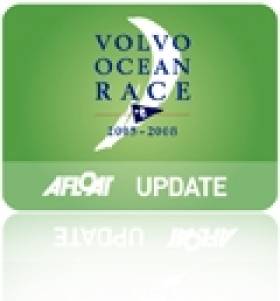Displaying items by tag: Volvo Ocean Race
Jameson Producer Signs On as Volvo Ocean Race Fest Sponsor
#VOLVO OCEAN RACE - The producer of Jameson whiskey has been announced as the spirit and wine sponsor of the Volvo Ocean Race Festival in Galway this summer.
The Galway Independent repors that Irish Distillers Pernod Ricard will be represented at the festival by their brands Jameson, GH Mumm champagne and Brancott Estate wine.
Managing director Pat Magee said: “We are delighted to be the spirits sponsor of the Volvo Ocean Race.
"It is a huge honour for Galway and Ireland to be chosen as the final destination, and a real opportunity for Ireland to show to an international audience our capabilities and successes."
As previously reported on Afloat.ie, organisers of the Volvo Ocean Race stopover this July have promised the event will be "bigger and better" than the previous visit in 2009.
The City of the Tribes competed with 81 locations around the world to be given the honour of hosting the final leg and the closing ceremony of the classic race.
The Galway Independent has more on the story HERE.
Volvo Ocean Race Brings Galway and Abu Dhabi Closer Together
#VOLVO OCEAN RACE - A golden dhow presented to the city of Galway by the Abu Dhabi Sailing and Yacht Club marks the new connection between these host ports of the 2011-2012 Volvo Ocean Race.
The Galway Advertiser reports on the Galway-Abu Dhabi Maritime Cultural Exchange initiative, which has already seen a Galway hooker race against traditional Arabian dhows in the Persian Gulf.
Both cities have been "engaged for many years with restoration of traditional boats and revival of sailing skills," says the paper.
Their co-operation is being seen as a model for using sailing as a catalyst to bring different cultures together. And the gesture will be reciprocated when Galway hosts the race finale this July, as six dhows and 60 Emirati crew will be hosted in the city for an exhibition race against a fleet of Galway hookers.
Meanwhile, Galway's Tidy Towns committee is determined to make the city look its best in time for the race's arrival.
The City of the Tribes scored well in 2011 after a long absence, but is looking to take things a step further for 2012.
Interested volunteers can contact the Galway Volunteer Centre, Mill Street at 091 539 930.
Volvo Ocean Race in Galway Will See Irish Food in Focus
#VOLVO OCEAN RACE - Top chef Maurice Keller was in Abu Dhabi last week to fly the flag for Irish food at the third stopover of the Volvo Ocean Race, Waterford Today reports.
Keller spent a few days away from Waterford's Arlington Lodge to join members of Good Food Ireland, Tourism Ireland and Irish embassy staff for a special 'Ireland Day' at the VOR Village.
The initiative was designed to promote Ireland as a prime tourist destination ahead of this summer's Volvo Ocean Race visit to Galway.
And food will play a major role in efforts to attract visitors to the finish line in Galway this July, according to the Limerick Post.
Foodies from across the mid-west will converge at a 'Foodie Forum' at the Galway-Mayo Institute of Technology on 2 Feburary, where plans to showcase Irish food in the city will be top of the agenda.
“At the launch of the countdown to the Volvo Ocean Race, the Let's Do It Galway team announced the four main pillars of the race next summer – marine, green, innovation and food," said Cáit Noone, head of the Hotel School at GMIT.
"The food pillar will provide Ireland with a global showcase opportunity to share with the world our food experiences and the outstanding locally sourced produce we have to offer.”
Night of Appreciation for VOR Galway Figurehead John Killeen
#VOLVO OCEAN RACE - An appreciation night was held in Galway last week for John Killeen, who has played a significant role in bringing the Volvo Ocean Race to the city.
As the Galway Independent reports, prominent business leaders and tourism officials were on hand at the Galway Bay Hotel on 17 January to honour the president of Let's Do It Galway - who was also one of three founding members of Ireland's entry in the 2008-2009 race, and was instrumental in bringing that race to the City of the Tribes.
Dan Murphy, president of tourism body Skål International Galway, said it was "only correct and proper" for the travel and tourism industries to recognise Killeen’s contributions to Galway and especially the work he has done bringing the Volvo Ocean Race back to Ireland.
NATO Task Force Neutralises Two Pirate Mother Ships
#Arabian Sea and Indian Ocean – Over the last 3 days in two separate operations Units of NATO'S Counter Piracy Task Force 508 successfully identified and neutralised two ocean going dhows that had been pirated and were subsequently being used as mother ships from which Somali pirates were intending to launch attacks on merchant shipping in the sea lanes off Somalia and the southern Arabian coasts.
In the first incident on Friday 6th January the USS CARNEY acting on intelligence from other counter piracy forces intercepted the Indian flagged dhow AL QASHMI off the south western coast of Oman. Following the dhow until it was safe to intercept her, the USS CARNEY carried out a text book approach to persuade the suspected pirates that they should stop and allow a compliant boarding of the dhow. Once onboard the dhow the USS CARNEY'S Board and Search Team quickly discovered that all evidence of potential piracy had been disposed of and questioning of the dhow's crew revealed that they had been hijacked with the 9 suspected pirates launching from a different dhow. The suspected pirates were released into their own boats and given sufficient fuel, provisions and water to make the passage back to Somalia. The crew of the AL QASHMI were offered assistance and then allowed to go about their lawful business.
The second incident took place on Saturday 7th January several hundred nautical miles away to the south west and close to the Somali coast when another dhow, this time of Iranian nationality, was identified as a potential pirate mother ship by the Danish warship HDMS ABSALON.
Having tracked the dhow through the night at first light the ABSALON launched her helicopter and confirmed that the dhow was carrying fast boats that were unusual to that type of dhow but of the type widely used by pirates. ABSALON then closed the dhow to hail it but instead of stopping as requested it turned towards the Somali coast. In order to force compliance ABSALON used warning shots to bring the dhow to a stop.
ABSALON'S Board and Search Team was all ready to launch and were quickly dispatched to the dhow under cover of the helicopter before the suspected pirates were able to dispose of potential evidence linking them to piracy and this was subsequently seized along with the 25 suspected pirates. The Boarding Team found 14 crew members, 5 Iranian nationals and 9 from Pakistan who were taken aboard the ABSALON to be interviewed and for medical checks though there were no injuries sustained in the use of warning shots or during the boarding operation.
The 25 suspected pirates have been detained onboard HDMS ABSALON pending further investigation and to ascertain if they can be prosecuted and a decision on that will be made in the next few days. The dhow's crew were given access to phone calls so they could give their relatives the good news of their release and they will also now be able to continue their voyage.
Commenting on a very busy few days for his Task Force, Rear Admiral (LH) Sinan Azmi TOSUN, Commander of NATO Counter Piracy Task Force 508 said "With these two disruptions overlapping and many miles apart NATO's Counter Piracy Task Force has demonstrated its flexibility, reach, resolve and capability to work with other counter piracy agencies to provide security on the sea lanes of this large ocean. Within the last two days NATO has disrupted two piracy-related dhows with a total of 34 suspected Somali pirates now unable to engage in unlawful acts on the high seas. This is a severe loss of capability for the pirate organisers and I congratulate my units on a job well done."
Showcase for Galway at VOR 'Irish Day' in Adu Dhabi
#VOLVO OCEAN RACE - Galway was showcased on Friday 6 January as part of special a 'Irish Day' celebration in Abu Dhabi, where the Volvo Ocean Race fleet is getting ready to embark on its next leg.
Galway Bay FM reports that the City of the Tribes was highlighted as a top international tourism destination - with the 'VOR Village' at Nimmo's Pier being a focus of discussions, according to Galway Mayor Hildegarde Naughton.
Earlier in the week saw the first sailing in Arab waters of the near-century-old Galway hooker Nora Bheag, which is in Abu Dhabi as part of a cultural exchange between these host ports of the 2011/2012 Volvo Ocean Race.
The race is set to finish in Galway on Tuesday 3 July 2012, attracting the world's media and thousands of visitors to Ireland's fifth largest city for the final prize-giving.
Banque Populaire V Takes Jules Verne Trophy, Smashing World Record
#WORLD RECORD - France's Banque Populaire V has smashed the record for the fastest yacht sailing around the world, shaving nearly three days off the previous best.
BBC News reports that the yacht's 14-man crew crossed the line at 45 days, 13 hours, 42 minutes and 53 seconds to claim the Jules Verne Trophy - knocking 2 days, 18 hours, 1 minute and 59 seconds off the standing world record set by Groupama 3 nearly two years ago.
The 40-metre trimaran, which last year also set a record time in the gruelling Fastnet Race, raced around the globe with an average speed of 26.5 knots.
And the Loïck Peyron-skippered yacht would have beaten the challenge even sooner had it not been delayed for almost two days due to bad weather.
"It was an amazing feeling crossing the line," said crew member Brian Thompson in an audio interview with sailor Hannah White.
Franck Cammas, skipper of Groupama 3 and currently competing in the Volvo Ocean Race, also offered his congratulations to the Banque Populaire team.
"Obviously it's a superb performance as it's always complicated to sail around the world," he told Sail World. "Aboard boats which go so fast, you have to know how to keep pace and drive them at the right speed so as not to break them.
"The crew of Banque Populaire knew how to do it and they did a fine job."
New Rig For Sanya (Photos)
#VOLVOOCEANRACE – The Discover Ireland backed Team Sany entry in the Volvo Ocean Race has been busy discovering Madagascar over the past few weeks as they awaited new rigging for their stricken yacht that pulled into the port of Talanero for emergency repairs before Christmas. Now it looks like they're getting ready to leave. Fingers crossed. See below photos attached from TEAM SANYA action today in Madagascar. SEE PHOTOS BELOW.
'The day we thought would never come has arrived', said Nick Bice, Team Sanya shore team manager. 'Today after nearly 3 weeks, the rig is going back in. Some of the sailing team arrived today and immediately got to work in preparing the boat to leave once the sea trials are done. The tentative plan is to step the rig today with sea trials planned all day tomorrow and on the Friday if needed. Mast going in now...'
New Year, New Rigging for Team Sanya
#VOLVOOCEANRACE – A pre-Christmas rig failure on board the Discover Ireland backed entry 'Team Sanya' in the Volvo Ocean Race continues to thwart the Chinese-Irish sailing team. The crew are hopeful now of fitting new rigging to the 70-foot ocean racer today at their emergency stop port of Madagascar. The yacht has yet to complete any of the legs of the race that started in November from Alicante, Spain.
Former race winner Mike Sanderson, Skipper and CEO of Team Sanya, issued an update on New Year's Eve stating that Team Sanya is now aiming to 'resume racing as soon as the new rigging is in place' and they hope to complete the first part of Leg Two of the 2011-12 Volvo Ocean Race.
The team suffered from a rigging failure on 19th December when they were leading the fleet during Leg Two and had to suspend racing and make an emergency stop in Fort Dauphin, a port in the South East of Madagascar.
Since then the team have been working flat out to make the necessary repairs as, due to the state-of-the art rigging used by the team, the whole side rigging system has had to be changed and the replacement rigging has now been created by Future Fibres. This rigging equipment left with shore team members from Valencia on 30th December and is due to arrive into Fort Dauphin today for the final preparation and curing process to begin.
The sailing team will gather in Fort Dauphin over the next few days and, along with the shore crew, they will step the re-built rig, tune and then sea-trial, with the aim of being able to resume racing on or around the 6thJanuary. The team is aiming to complete the first section of Leg Two that will take them to the safe haven port. By completing this part of Leg Two they are then entitled, under the Notice of Race rules, to claim average points for the second short stage of Leg Two, the InPort race in Abu Dhabi and the first stage of Leg Three.
Team Sanya is then forced by race rules to await for the fleet to return to the safe haven port during Leg Three and will then re-join the race into their home part of Sanya.
Mike Sanderson, commented on this latest decision:
"The rigging failure was a massive disappointment to us as a team. We were having a great leg and felt that we were showing for the first time what this team has the potential to deliver given an opportunity opening up for us. It has taken quite some time to come to terms with this second blow to our campaign but that's all part of what can happen during a Volvo Ocean Race and we are more determined than ever to get racing again.
We have spent considerable time assessing the options and weighing up what might be seen as a relatively short term gain of completing this leg against the need to ensure the boat and team are 100% ready and race fit for Leg Three and onwards. After discussion with our key sponsors, we made the decision to do everything we can to complete this part of Leg Two and maximize the points we can gain which could be of value to us later in the race. We are still very dependent on everything going right with the application of the new rigging down in Madagascar but very hopeful that we can resume racing as soon as possible"
Discover Ireland's Volvo Entry 'Sanya' Makes Landfall in Madagascar
#VOLVOOCEANRACE – The Discover Ireland backed entry in the Volvo Ocean Race Team Sanya - the sailors and the boat - have all safely arrived in Talañero (sometimes called Taolagnero) in Madagascar, an unexpected pitstop in leg two due to rigging problems. The crew is cleaning the boat and doing some work to make everything secure. Communications is a little difficult with the crew as they have no mobile phones with them nor laptops. Skipper Mike Sanderson has gone off to basic supplies (like phones, sim cards and flip flops!
View Larger Map



























